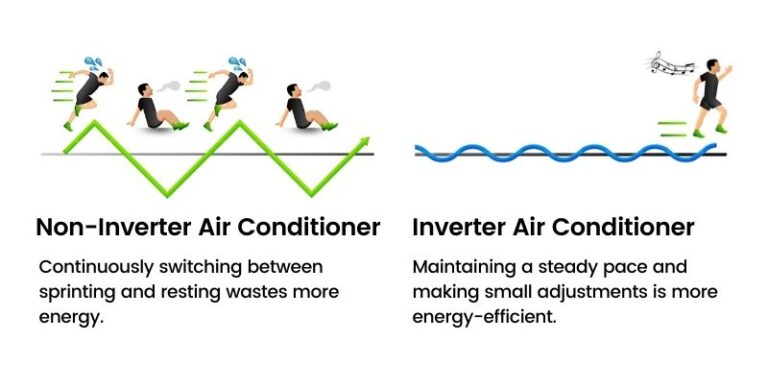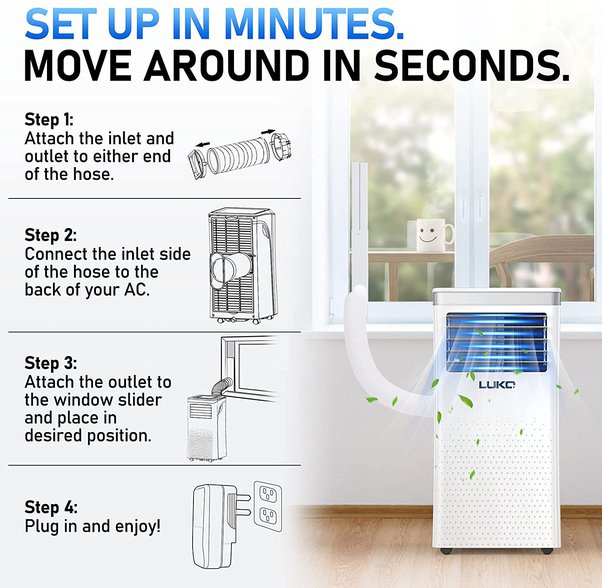What Is The Difference Between Vrf And Vrv Air Conditioning: Explained
VRF (Variable Refrigerant Flow) and VRV (Variable Refrigerant Volume) air conditioning systems are essentially the same. Both terms refer to advanced HVAC technology allowing individual zone temperature control.
VRF and VRV systems offer efficient, flexible cooling and heating solutions for commercial and residential buildings. Developed by Daikin, VRV stands for Variable Refrigerant Volume and is a trademarked term. Other manufacturers use the term VRF, meaning Variable Refrigerant Flow, for similar systems.
These systems use refrigerant as the cooling and heating medium, circulating it within multiple evaporators. The technology adjusts the refrigerant flow to various zones, ensuring optimal energy use and comfort. Ideal for large buildings, VRF/VRV systems reduce energy consumption and provide precise temperature control.
Introduction To Vrf And Vrv
Variable Refrigerant Flow (VRF) and Variable Refrigerant Volume (VRV) are modern air conditioning systems. Both terms often confuse people. This section will explain their basic concepts and importance in HVAC.
Basic Concepts
VRF stands for Variable Refrigerant Flow. VRV stands for Variable Refrigerant Volume. Both refer to the same technology. The term VRV is a trademark of Daikin Industries. Other companies use the term VRF.
These systems use refrigerant as the cooling and heating medium. They can control the amount of refrigerant flowing to different zones. This ensures energy efficiency and comfort.
| Feature | VRF | VRV |
|---|---|---|
| Definition | Variable Refrigerant Flow | Variable Refrigerant Volume |
| Trademark | General term | Daikin Industries |
Importance In Hvac
VRF and VRV systems are crucial in modern HVAC. They offer precise temperature control. They are energy-efficient and save costs.
These systems are suitable for various buildings. They work well in residential, commercial, and industrial settings. They provide both cooling and heating functions.
Benefits include:
- Energy efficiency
- Cost savings
- Flexible installation
- Quiet operation
These systems improve indoor air quality. They reduce the carbon footprint of buildings. This makes them a sustainable choice for HVAC needs.
Technology Behind Vrf
The technology behind Variable Refrigerant Flow (VRF) air conditioning systems is advanced. VRF systems provide efficient and flexible cooling and heating solutions. They are commonly used in commercial buildings and large residential complexes.
System Components
VRF systems consist of several key components that work together:
- Outdoor Units: These are the core of the system. They house the compressor and heat exchanger.
- Indoor Units: These units are installed within the building. They distribute the conditioned air.
- Refrigerant Piping: This network of pipes connects the outdoor and indoor units. It carries the refrigerant throughout the system.
- Control Systems: These include remote controllers and central management systems. They allow users to manage the temperature settings.
Working Mechanism
The working mechanism of a VRF system is both sophisticated and efficient:
- The outdoor unit compresses the refrigerant and sends it to the indoor units.
- The indoor units distribute the conditioned air to specific zones.
- The refrigerant then absorbs heat from the indoor spaces.
- The heated refrigerant returns to the outdoor unit for cooling.
This cyclical process allows for precise temperature control in different areas. It also ensures energy efficiency and comfort.
Technology Behind Vrv
VRV (Variable Refrigerant Volume) air conditioning systems are advanced. They offer precise control over the indoor climate. These systems are energy-efficient and customizable.
System Components
VRV systems have several key components. These include:
- Outdoor Units: These are the heart of the system. They contain the compressor and the condenser.
- Indoor Units: These units distribute cool or warm air inside rooms.
- Refrigerant Piping: This connects the outdoor and indoor units. It allows refrigerant to flow between them.
- Control Systems: These manage the operation of the system. They ensure optimal performance and energy efficiency.
Working Mechanism
VRV systems use advanced technology to control the refrigerant flow. The working mechanism includes:
- Variable Speed Compressors: These adjust the refrigerant flow. They match the cooling or heating demand.
- Multiple Indoor Units: Each unit can be controlled independently. This allows for customized climate control.
- Heat Recovery: VRV systems can transfer heat from one area to another. This increases energy efficiency.
- Smart Controls: These systems use sensors and software. They optimize performance and reduce energy use.
The VRV system is efficient and flexible. It provides comfort and saves energy.
Key Differences
Understanding the key differences between VRF (Variable Refrigerant Flow) and VRV (Variable Refrigerant Volume) air conditioning systems can help you make an informed decision. While both systems are designed to provide efficient cooling and heating solutions, they have distinct operational characteristics and efficiency levels.
Operational Differences
VRF systems are known for their ability to control the amount of refrigerant sent to each indoor unit. This allows for precise temperature control in different zones.
VRV systems, on the other hand, are a specific brand of VRF systems developed by Daikin. They operate similarly but are optimized with proprietary technology for enhanced performance.
Both systems use a network of indoor and outdoor units. The primary operational difference lies in the branding and technological enhancements unique to VRV systems.
Efficiency Comparison
When comparing efficiency, both VRF and VRV systems are designed for energy savings. They use advanced inverter technology to adjust the compressor speed based on cooling or heating demands.
| Feature | VRF | VRV |
|---|---|---|
| Energy Efficiency | High | Very High |
| Temperature Control | Precise | Very Precise |
| Brand-Specific Technology | No | Yes (Daikin) |
Both systems offer excellent energy efficiency. VRV systems often have a slight edge due to proprietary enhancements by Daikin.
Choosing between VRF and VRV depends on specific needs and preferences. Both offer reliable and efficient solutions for modern air conditioning requirements.
Installation And Maintenance
Understanding the installation and maintenance of VRF and VRV air conditioning systems is crucial. These systems offer different advantages and challenges. Below, we explore their installation process and maintenance requirements.
Installation Process
The installation of a VRF (Variable Refrigerant Flow) system involves several steps. It requires careful planning and precise execution. Technicians connect indoor units to a single outdoor unit. This setup allows for individual room control.
The installation of a VRV (Variable Refrigerant Volume) system is similar. VRV systems also connect multiple indoor units to one outdoor unit. The primary difference lies in the brand and specific technology used.
| Aspect | VRF | VRV |
|---|---|---|
| Planning | Complex | Complex |
| Connections | Multiple indoor to one outdoor | Multiple indoor to one outdoor |
| Control | Individual room control | Individual room control |
Maintenance Requirements
Both VRF and VRV systems require regular maintenance. Proper upkeep ensures efficiency and longevity. Below are common maintenance tasks:
- Filter cleaning: Regularly clean or replace filters.
- Refrigerant checks: Ensure proper refrigerant levels.
- System diagnostics: Use diagnostic tools for system checks.
- Component inspection: Inspect fans, coils, and other components.
Maintenance for both systems is similar, but specific tasks may vary. Always follow the manufacturer’s guidelines for best results.

Credit: m.youtube.com
Energy Efficiency
Energy efficiency is a crucial factor in choosing between VRF and VRV air conditioning systems. Both systems aim to provide optimal cooling and heating while reducing energy consumption. Understanding their energy efficiency can help in making an informed decision.
Energy Consumption
VRF (Variable Refrigerant Flow) systems adjust the refrigerant flow to meet the precise demands of each zone. This results in lower energy consumption. These systems operate at varying speeds, ensuring only the needed amount of energy is used.
VRV (Variable Refrigerant Volume) systems, developed by Daikin, also offer energy-saving benefits. They control the refrigerant volume delivered to each zone. This ensures efficient use of energy and reduces wastage.
Both systems use advanced inverter technology. This allows them to operate at partial loads, enhancing their energy efficiency. Here’s a quick comparison of their energy consumption:
| Feature | VRF | VRV |
|---|---|---|
| Technology | Variable Refrigerant Flow | Variable Refrigerant Volume |
| Energy Control | Adjusts Flow | Adjusts Volume |
| Efficiency | High | High |
Cost Savings
One of the major benefits of both VRF and VRV systems is cost savings. Their high energy efficiency translates to lower utility bills. By using energy only as needed, they help reduce operational costs.
Businesses and homeowners can benefit from significant cost savings over time. Both systems also offer long-term financial benefits due to their durable and reliable performance. Here’s a breakdown of potential cost savings:
- Lower utility bills due to reduced energy consumption.
- Reduced maintenance costs due to advanced technology.
- Longer lifespan, resulting in fewer replacements.
Investing in VRF or VRV systems can lead to substantial savings. Their efficient operation ensures you get the best value for your money.
Applications
Understanding the applications of VRF (Variable Refrigerant Flow) and VRV (Variable Refrigerant Volume) air conditioning systems is crucial. These systems offer flexibility, energy efficiency, and comfort. They cater to different settings like homes and commercial spaces.
Residential Use
VRF systems are ideal for homes. They provide precise temperature control in each room. This makes them perfect for multi-story houses. Their quiet operation ensures a peaceful environment. Homeowners can enjoy a comfortable living space without noise.
VRV systems also suit residential use. They offer similar benefits as VRF systems. These systems are great for larger homes. Their advanced technology ensures even cooling and heating. Homeowners can control the climate in different zones.
Both systems are energy-efficient. They help reduce electricity bills. Families can enjoy comfort while saving money. Smart controls allow easy management of indoor climate. These systems add value to homes.
Commercial Use
VRF systems excel in commercial settings. They are perfect for office buildings, hotels, and shopping centers. Multiple indoor units can be connected to one outdoor unit. This ensures efficient cooling and heating for various zones.
VRV systems are also popular in commercial spaces. They offer similar advantages as VRF systems. Their flexibility allows for easy installation in complex buildings. These systems are suitable for large areas with varying cooling and heating needs.
Both systems help businesses save on energy costs. They provide a comfortable environment for employees and customers. Advanced controls ensure easy management of different zones. Commercial properties can benefit from these efficient systems.
| Feature | VRF | VRV |
|---|---|---|
| Ideal for | Homes, Offices | Homes, Hotels |
| Energy Efficiency | High | High |
| Zone Control | Yes | Yes |
| Noise Levels | Low | Low |

Credit: www.youtube.com
Choosing The Right System
Choosing the right air conditioning system for your needs can be challenging. VRF (Variable Refrigerant Flow) and VRV (Variable Refrigerant Volume) systems offer advanced cooling solutions. Both systems provide efficient climate control. But how do you decide which one is best for you? Let’s explore the key factors to consider and expert recommendations.
Factors To Consider
When deciding between VRF and VRV systems, several factors come into play:
- Space Requirements: VRF systems are ideal for medium to large spaces. VRV systems work well in both small and large areas.
- Energy Efficiency: Both systems are energy-efficient. VRF systems offer more precise temperature control.
- Installation Costs: VRF systems may have higher upfront costs. VRV systems can be more cost-effective initially.
- Maintenance: VRF systems require regular maintenance checks. VRV systems also need periodic servicing.
- Scalability: VRF systems are easily scalable. VRV systems offer flexible configurations.
Expert Recommendations
Experts often recommend VRF systems for commercial buildings. They offer efficient cooling for large spaces. For residential settings, VRV systems can be a better fit. They provide a balance of efficiency and cost-effectiveness. Here are some tips:
- Consult a Professional: Get advice from a certified HVAC technician.
- Analyze Your Needs: Consider your specific cooling requirements.
- Compare Costs: Evaluate both initial and long-term costs.
- Check Compatibility: Ensure the system fits your existing infrastructure.
Choosing the right system depends on your specific needs. Evaluate all factors carefully for the best decision.

Credit: www.comfortairny.com
Frequently Asked Questions
Which Is Best, Vrv Or Vrf?
VRV and VRF both offer efficient cooling. VRF provides better individual control, ideal for larger buildings. VRV suits smaller spaces. Choose based on your needs.
What Is Vrv In Air Conditioning?
VRV in air conditioning stands for Variable Refrigerant Volume. It optimizes energy use by adjusting refrigerant flow. This system provides precise temperature control, making it efficient and cost-effective. Ideal for large buildings, VRV systems enhance comfort and reduce energy costs.
What Is The Difference Between Vrf And Vav Air Conditioning Systems?
VRF systems use refrigerant for both heating and cooling, providing individual zone control. VAV systems use air ducts and vary airflow to maintain temperature.
Conclusion
Understanding the difference between VRF and VRV air conditioning is crucial. VRF stands for Variable Refrigerant Flow, while VRV means Variable Refrigerant Volume. Both offer efficient cooling and heating solutions. Choosing the right system depends on specific needs and building requirements.
Always consult with a professional to make the best decision for your space.







